How Do The Animals In An Ecosystem Mainly Acquire The Sun's Energy?
24.v: Energy in Ecosystems
- Page ID
- 17818
It's easy to run into why the aquatic creature in Figure \(\PageIndex{one}\) is commonly called a sea affections. It has gossamer-like "wings" that flutter gently and help it swim, and its diaphanous trunk gives it an otherworldly advent. Although it appears angelic, this tiny invertebrate is really a vicious predator. It has a hugger-mugger weapon in the form of six sharp tentacles hidden in its face up. When an unsuspecting prey drifts by, the sea angel turns into a devilish killing motorcar. It lashes out its tentacles, grabs its prey, and so slowly eats it. Predators similar sea angels obtain free energy from casualty organisms. This is just one of the ways that organisms obtain free energy.
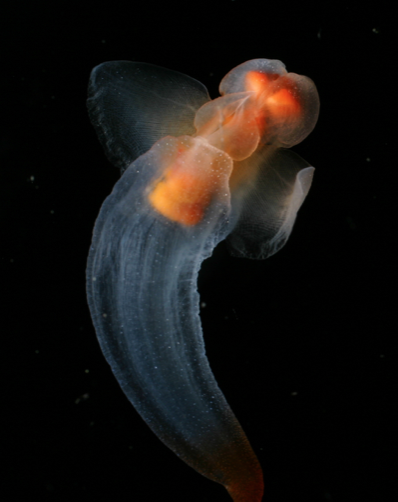
How Organisms Obtain Energy
In that location are two basic types of organisms in terms of how they obtain energy: autotrophs and heterotrophs.
Autotrophs
Autotrophs are organisms that use energy directly from the sun or from chemical bonds. Commonly called producers, they employ energy and uncomplicated inorganic compounds to produce organic molecules. Autotrophs are vital to all ecosystems because all organisms demand organic molecules and merely autotrophs can produce them from inorganic compounds. In that location are ii bones types of autotrophs: photoautotrophs and chemoautotrophs.
Photoautotrophs
Photoautotrophs are autotrophs that use energy from sunlight to brand organic compounds by photosynthesis. Photoautotrophs include plants, algae, and many leaner, equally shown in Table \(\PageIndex{1}\). They are the primary producers in the vast majority of ecosystems on Earth.
Chemoautotrophs
Chemoautotrophs utilise energy from chemical bonds to brand organic compounds by chemosynthesis. Chemoautotrophs include certain bacteria and archaeans. They are the principal producers in ecosystems that form effectually hydrothermal vents and in hot springs.
| Blazon of Photoautotroph | Type of Ecosystem(s) | Instance | Example |
|---|---|---|---|
| Plants | Terrestrial | Tree | Grasses |
| Algae | Aquatic | Diatoms | Seaweed |
| Leaner | Aquatic and Terrestrial | Cyanobacteria | Purple Bacteria |
Heterotrophs
Heterotrophs are organisms that obtain free energy from other living things. Like sea angels, they take in organic molecules past consuming other organisms, so they are commonly chosen consumers. Heterotrophs include all animals and fungi likewise equally many protists and bacteria. Heterotrophs tin can exist classified by what they commonly eat as herbivores, carnivores, omnivores, or decomposers.
Herbivores
Herbivores are heterotrophs that directly consume producers such as plants or algae. They are a necessary link betwixt producers and other heterotrophs such as carnivores. Examples of herbivores include deer, rabbits, sea urchins, grasshoppers, mice, and the larvae of many insects, similar the caterpillar in Figure \(\PageIndex{ii}\). Herbivorous animals typically have mouthparts or teeth adapted to grasping or grinding the tough materials in plants. Many herbivores have mutualistic intestinal microbes that help them break downwards hard-to-digest plant matter.

Carnivores
Carnivores are heterotrophs that consume animals; examples of heterotrophs include lions, polar bears, hawks, salmon, and spiders. Obligate carnivores (such every bit cats) are unable to digest plants and then they can just eat animals. Facultative carnivores (such as dogs) can digest plant matter merely plants are not an important food source for them. Most carnivores are predators that catch and kill live animals for consumption. Some carnivores, called scavengers, notice and eat animals that take already died, such equally the prey remnants left behind by predators. Examples of scavengers include vultures, hyenas, and blowflies, like those in Effigy \(\PageIndex{iii}\).

Omnivores
Omnivores are heterotrophs that consume both plants and animals. They include pigs, brownish bears, gulls, crows, and humans. Omnivores actually fall on a continuum between herbivores and carnivores. Some omnivores swallow more plants than animals, whereas other omnivores eat more animals than plants. Some organisms are seasonally omnivorous, meaning that they consume plants in some seasons and animals in other seasons. An instance is a grizzly bear. When salmon or other fish are plentiful, the bears are primarily carnivorous; just when berries ripen and become plentiful, the bears are mainly herbivorous. Some omnivores swallow animals during some life stages and plants during other life stages. For instance, almost tadpoles are herbivores that eat algae, whereas developed frogs are carnivores that consume insects and other invertebrates.
Decomposers
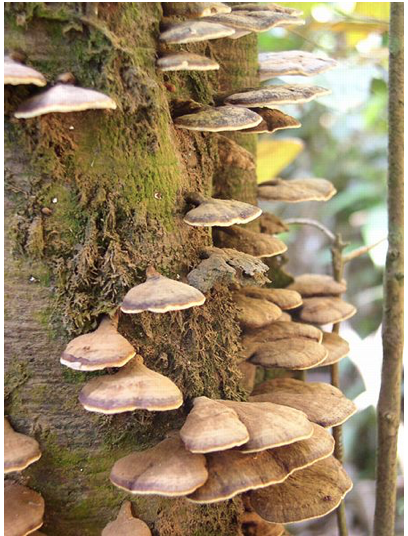
Decomposers are heterotrophs that interruption down and feed on the remains of expressionless organisms and other organic wastes such every bit feces. In the procedure, they release simple inorganic molecules back to the environment. Producers tin then use the molecules to brand new organic compounds. Decomposers are classified by the type of organic affair they pause down. Two types are detritivores and saprotrophs.
- Detritivores are decomposers that ingest and digest detritus, which includes dead leaves, animal feces, and other organic debris that collects on the ground or at the bottom of a torso of water. Terrestrial detritivores include earthworms and dung beetles. Aquatic detritivores include "bottom feeders" such as body of water cucumbers and catfish.
- Saprotrophs are decomposers that feed on expressionless organic affair by secreting digestive enzymes and digesting it externally, rather than past ingesting the affair and digesting it internally. Saprotrophs include fungi and unmarried-celled protozoa. Fungi, like those in Effigy \(\PageIndex{4}\), are the just organisms that can decompose wood.
Models of Energy Flow
Free energy enters all ecosystems from the sun or from inorganic chemicals. The energy and then flows through ecosystems from producers, who tin can utilise inorganic forms of energy, to consumers, who can obtain energy just from organic compounds in other living things. Ecologists unremarkably represent this catamenia of free energy through the organisms of an ecosystem with models such equally food chains and food webs. These models correspond feeding relationships, showing who eats whom. Although the models are more often than not oversimplifications of reality, they take proven useful for testing hypotheses about ecosystems and identifying common patterns that many ecosystems share.
Nutrient Chains
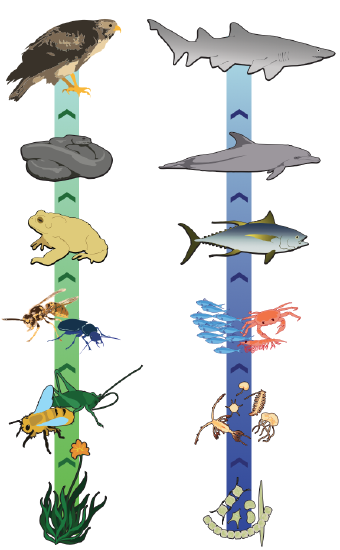
A food chain is an ecological model that represents a unmarried pathway through which energy flows in an ecosystem. Nutrient bondage are virtually ever simpler than what actually happens in nature because almost organisms consume — and are consumed by — more than ane species. 2 examples of nutrient chains, one terrestrial and ane aquatic, are shown in Figure \(\PageIndex{five}\). In both food chains, the organisms at the bottom are producers. In the terrestrial food chain, the producers are grasses, and in the aquatic nutrient chain, the producers are tiny plants called phytoplankton. The producers in each food chain are consumed by herbivores. The herbivores, in turn, are consumed by carnivores, which are themselves the prey of other carnivores. The top organism in each food chain is a predator — chosen an apex predator — that is not preyed upon by whatsoever other species.
Many nutrient chains, including those pictured in Effigy \(\PageIndex{5}\):, do not include decomposers. Yet, decomposers are a meaning component of energy flow in every ecosystem. Decomposers break down any remaining organic affair (whether from producers or consumers), using some of the energy it contains and releasing excess nutrients back into the environment.
Food Webs
A food web is an ecological model that represents multiple pathways through which energy flows in an ecosystem. It generally includes many intersecting food chains. Although food webs, like food chains, are usually simplifications of reality, they do demonstrate that most organisms eat, and are eaten by, more than one species. Two examples of nutrient webs, one terrestrial, and one aquatic, are shown in Effigy \(\PageIndex{half-dozen}\). Consider the grasshopper in the terrestrial food web as an example. It is an herbivore that consumes only plants, but the grasshopper is consumed by multiple other consumers, including spiders, mice, birds, and frogs.
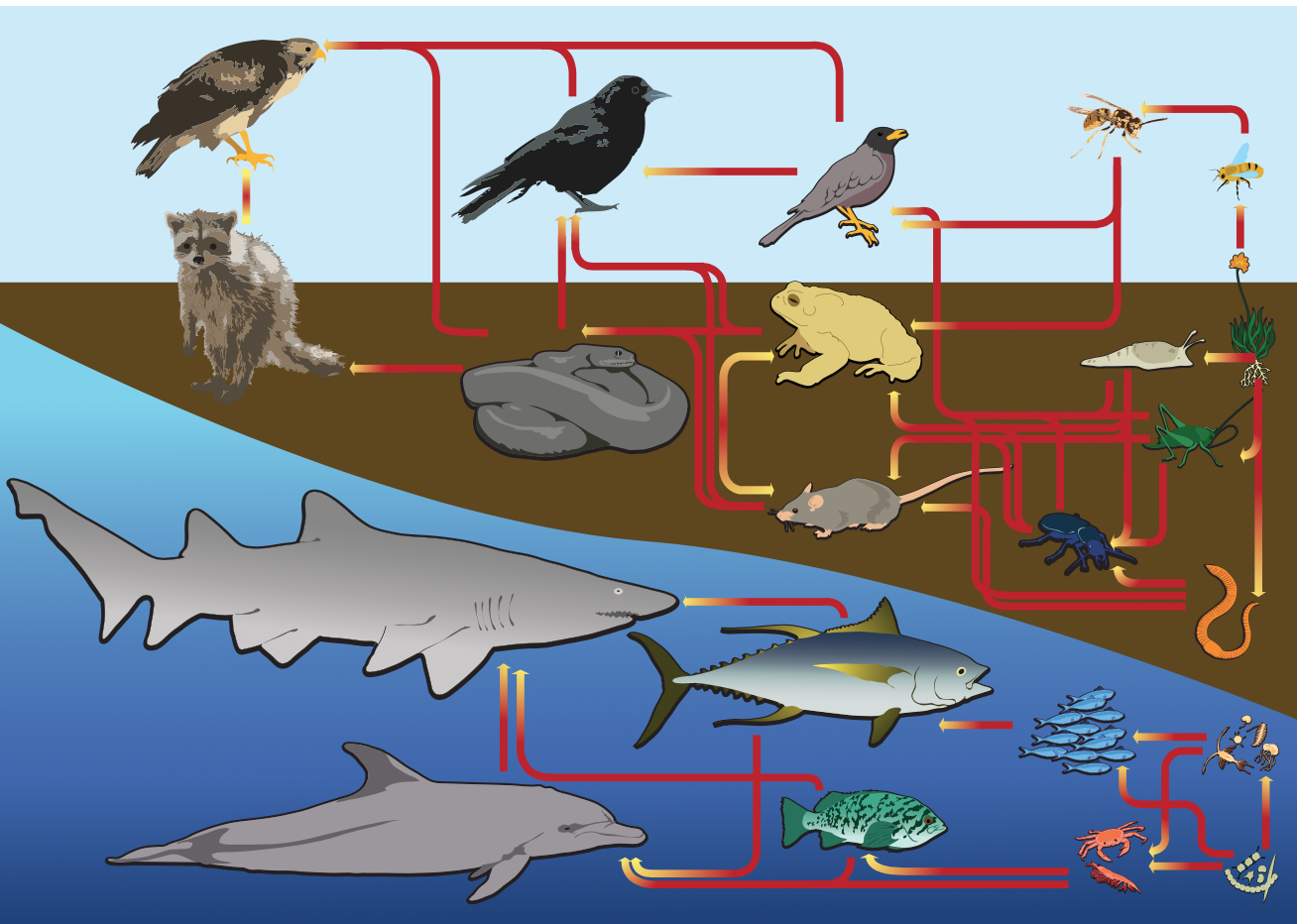
Trophic Levels
| Trophic Level | How Information technology Obtains Energy | Example |
|---|---|---|
| 1st trophic level: producers | photosynthesis or chemosynthesis | grass |
| 2nd trophic level: master consumers | consumes producers | rabbit |
| 3rd trophic level: secondary consumers | consumes primary consumers | snake |
| ivthursday trophic level: tertiary consumers | consumes secondary consumers | hawk |
The different feeding positions in a food concatenation or nutrient web are called trophic levels. The main trophic levels are defined in Table \(\PageIndex{2}\). All nutrient chains and nutrient webs have at to the lowest degree 2 or three trophic levels, ane of which must be producers (1st trophic level). By and large, there is a maximum of four trophic levels, and only rarely are there five or more trophic levels. Most consumers actually feed at more than than one trophic level. Humans, for example, are primary consumers when they eat plants such as vegetables. They are secondary consumers when they eat meat from herbivores such as cattle. They are tertiary consumers when they eat secondary consumers such as salmon, which eat smaller fish.
Trophic Levels and Energy
Energy is passed up a food concatenation or nutrient web from lower to college trophic levels. However, as shown in the energy pyramid in Effigy \(\PageIndex{7}\), only nigh x per centum of the energy at i trophic level is really passed upwards to the side by side college trophic level. The other ninety per centum of free energy at each trophic level is used by organisms at that level for metabolism, growth, and repair. Metabolism generates heat (thermal energy), which is the free energy that is lost to the environs. Some free energy is also lost as incompletely digested nutrient that is excreted. The decline in free energy from one trophic level to the next explains why there are rarely more four trophic levels in a food concatenation or food web. There is more often than not inadequate energy remaining above four trophic levels to back up organisms at additional trophic levels
Trophic Levels and Biomass
With less energy at higher trophic levels, it is by and large the case that fewer organisms can exist supported at college levels. Although individual organisms tend to be larger in size at higher trophic levels, their smaller numbers result in less biomass at college levels. Biomass is the amount of organic matter present in an private organism or in all the organisms at a given trophic level. The decrease in numbers and biomass of organisms from lower to higher trophic levels is represented by the ecological pyramid in Figure \(\PageIndex{vii}\).
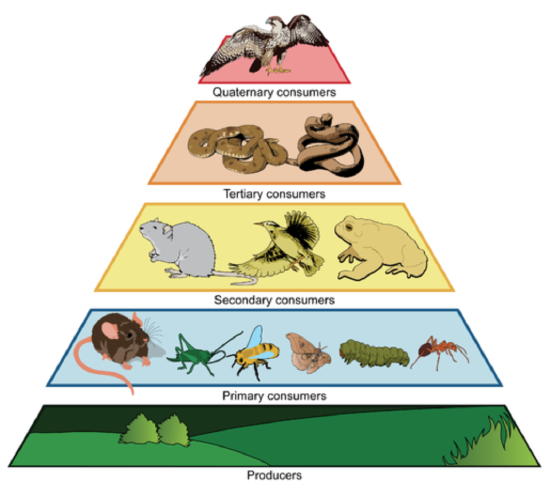
Review
- What are autotrophs? Name three types of organisms that are autotrophs.
- Compare and dissimilarity photoautotrophs and chemoautotrophs.
- Define heterotroph.
- What types of organisms are heterotrophs?
- How are heterotrophs classified on the basis of what they consume?
- What are nutrient bondage and nutrient webs?
- What are the trophic levels? Place the different trophic levels in a food concatenation or nutrient web.
- Why are in that location rarely more four trophic levels in an ecosystem?
- How practise the numbers and biomass of organisms ordinarily modify from lower to higher trophic levels?
- Explain the phenomenon of bioaccumulation.
- Herbivores are at which trophic level?
- \(1^{st}\)
- \(2^{nd}\)
- \(3^{rd}\)
- \(iv^{th}\)
- True or False. In some food bondage, chemoautotrophs are the blazon of organism at the 1sttrophic level.
- True or False. Apex predators are at the trophic level that contains the nearly free energy.
- Which of the following is not a heterotroph?
- An apple tree
- A mushroom
- A polliwog
- A and B
- Which of the post-obit terms use to humans: autotroph; heterotroph; carnivore; omnivore; herbivore; producer; main consumer; tertiary consumer
Explore More
Attributions
- Clione by Kevin Raskoff (NOAA Photo Library), public domain via Wikimedia Commons
- Raunkiærseg, public domain via Wikimedia Eatables
- Alpine grass past Polishname, public domain via Wikimedia Commons
- Diatom by Prof. Gordon T. Taylor, Stony Brook Academy (corp2365, NOAA Corps Collection ), public domain via Wikimedia Commons
- Codium by Flyingdream, public domain via Wikimedia Commons
- Phormidium past USGS, public domain
- Rhodospirillum rubrum by pookypoo87, public domain via Wikimedia Commons
- Nematus ribesii feeding on leafage past Daniel Mietchen, licensed CC0 via Wikimedia Eatables
- The fly banquet by LASZLO ILYES, CC By 2.0 via Wikimedia Eatables
- Fungi in Borneo by Cayce, CC Past 2.0 via Wikimedia Commons
- Simplified food concatenation past LadyofHats (Mariana Ruiz Villarreal), defended CC0 via Wikimedia Commons
- Food web by LadyofHats (Mariana Ruiz Villarreal), dedicated CC0 via Wikimedia Commons
- Ecological pyramid by CK-12 licensed CC BY-NC 3.0
- Text adapted from Human Biology by CK-12 licensed CC BY-NC 3.0
Source: https://bio.libretexts.org/Bookshelves/Human_Biology/Book:_Human_Biology_%28Wakim_and_Grewal%29/24:_Ecology/24.05:_Energy_in_Ecosystems
Posted by: foltzguith1992.blogspot.com

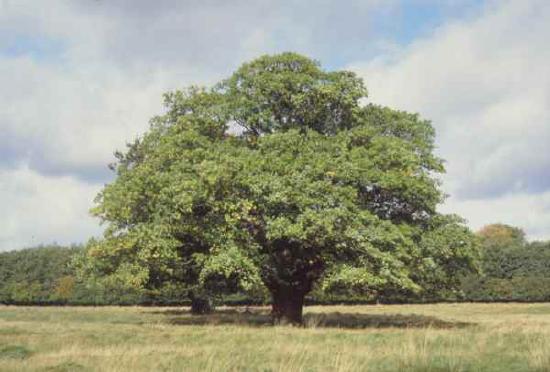
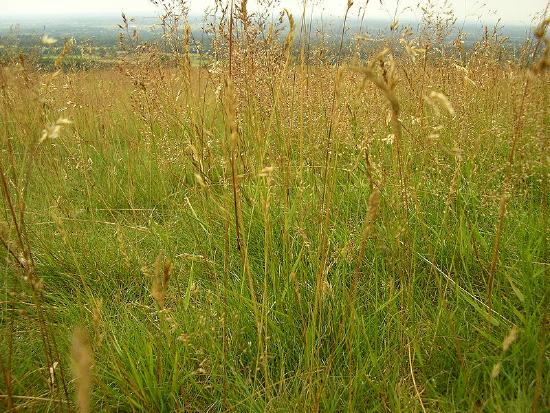
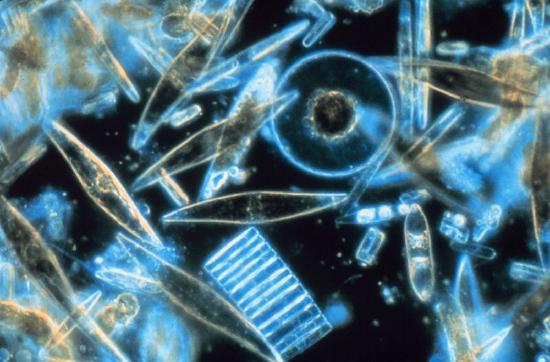
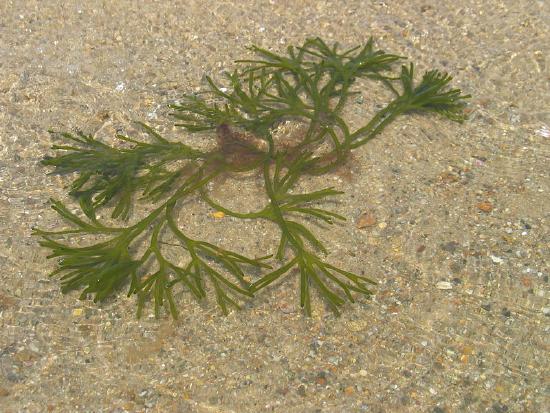
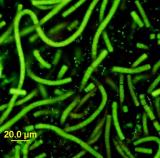
0 Response to "How Do The Animals In An Ecosystem Mainly Acquire The Sun's Energy?"
Post a Comment